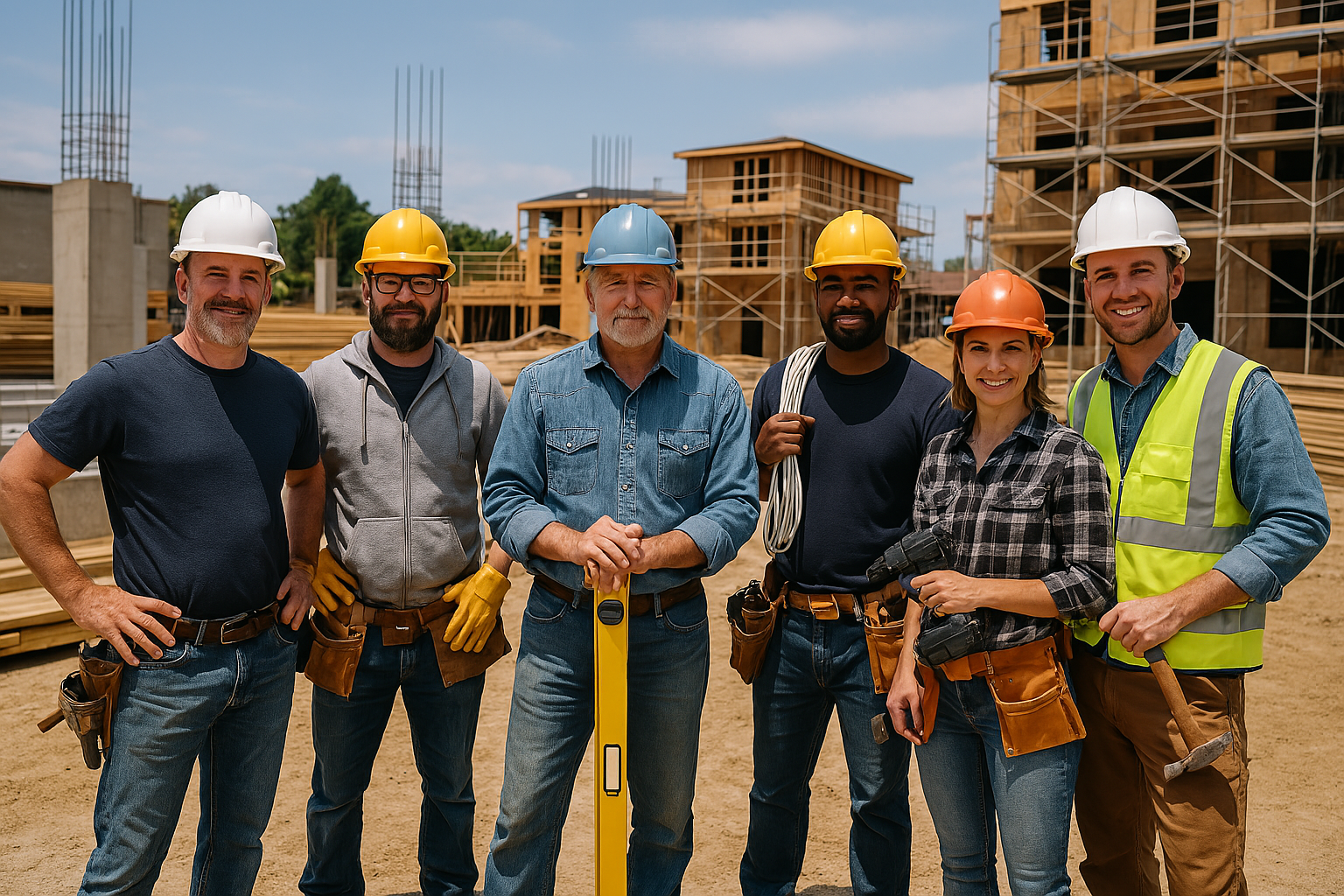
Check out our app!
Explore more features on mobile.
Building a Smart Home From Scratch: The Ultimate Integration Guide
When building a new home, incorporating smart technology from the ground up offers unparalleled efficiency, convenience, and long-term value. Unlike retrofitting existing structures, planning for smart home integration during construction eliminates compatibility issues, reduces costs, and creates a seamless technological ecosystem. This comprehensive guide walks you through integrating cutting-edge smart technology into each stage of the construction process, helping you build a future-proof home with maximum functionality and minimal compromises.
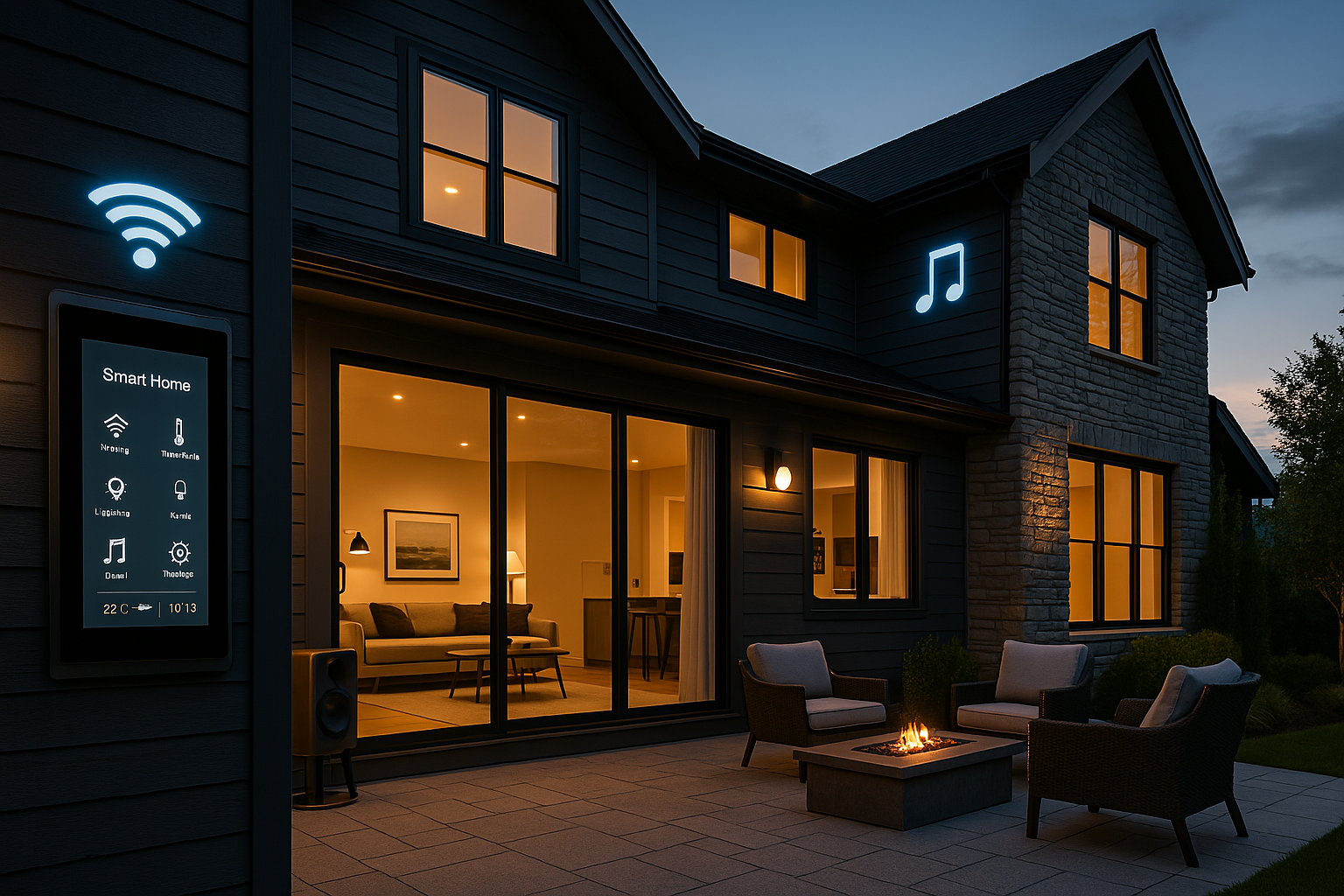
[Image: Modern Smart Home with Integrated Technology]
Smart Home Planning: Foundation for Success
Before breaking ground, establish a comprehensive smart home technology plan that aligns with your lifestyle needs and budget constraints. This critical planning phase creates the blueprint for all technological integrations throughout the construction process.
Key Planning Considerations:
- Connectivity Infrastructure: Determine your home’s primary connectivity backbone—wired (Ethernet), wireless (Wi-Fi 6/6E), or a hybrid approach. Despite advances in wireless technology, structured wiring remains the most reliable foundation.
- Technology Ecosystem Selection: Choose between open-standard platforms (Matter, Thread, Zigbee, Z-Wave) or manufacturer-specific ecosystems (Apple HomeKit, Google Home, Amazon Alexa). Consider compatibility with future devices and your preferences for voice assistants.
- Network Security Planning: Design a network security architecture that protects your connected devices and personal data through segmented networks, advanced firewall configurations, and regular update protocols.
- Power Backup Systems: Plan for uninterruptible power supplies (UPS) and whole-house generators to maintain critical smart home functions during outages.
Site Preparation & Smart Integration
Smart home technology considerations begin during the earliest stages of site preparation, influencing decisions about property orientation, excavation planning, and utility connections.
Smart Technology Integration During Site Preparation:
- Orientation Optimization: Position the home to maximize natural light for energy efficiency while accounting for solar panel placement and outdoor camera coverage.
- Internet Service Provider (ISP) Assessment: Evaluate available high-speed internet options and plan for fiber optic conduit installation during excavation if fiber service is available or anticipated in your area.
- Underground Sensor Planning: Map locations for underground systems like smart irrigation, driveway sensors, and perimeter security during excavation planning.
- Geothermal System Preparation: If incorporating geothermal HVAC, coordinate loop field installation with excavation work and plan integration with smart climate control systems.
| Site Preparation Element | Smart Home Consideration | Long-Term Benefit |
|---|---|---|
| Property Orientation | Solar optimization, security camera positioning | 15-25% increased energy efficiency |
| Excavation Planning | Underground conduits for future technology | Avoid $3,000-$5,000 in future trenching costs |
| Utility Connections | Fiber optic planning, smart meter integration | Future-proof connectivity, utility savings of 8-12% |
Foundation Work with Future Tech in Mind
Your home’s foundation presents a critical opportunity to establish technological infrastructure that would be prohibitively expensive to add later. Incorporating smart home considerations during foundation work creates the literal groundwork for future technology.
Smart Technology in Foundation Construction:
- Conduit Installation: Embed conduits in foundation walls for future wiring needs, including power, data, and security systems that connect to exterior areas.
- Foundation Sensors: Install moisture, temperature, and structural integrity monitoring sensors within the foundation to track conditions and detect potential issues before they become problematic.
- Radon Mitigation Integration: Plan for smart radon mitigation systems with automated monitoring and ventilation control if building in high-radon areas.
- Below-Grade Technology Rooms: Consider incorporating a basement or crawlspace area specifically designed for technology infrastructure, including proper ventilation, power, and security features.
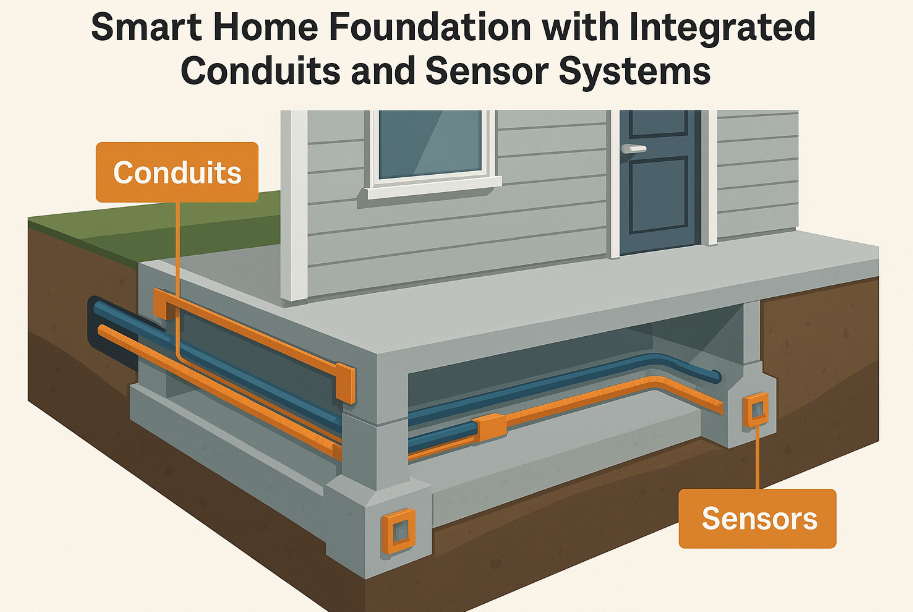
[Image: Foundation with Integrated Technology Infrastructure]
Framing & Structural Considerations
The framing stage offers critical opportunities to design and prepare for technology integration throughout the home’s structure before walls are closed. Smart home considerations during framing can significantly reduce future modification costs and maximize system performance.
Smart Home Integration During Framing:
- Structured Wiring Pathways: Create dedicated chase ways and blocking for current and future wiring needs throughout the structure.
- Reinforced Mounting Points: Install additional blocking and support for wall-mounted displays, in-wall speakers, and automation equipment like motorized shades and projector lifts.
- Centralized Distribution Hub: Frame a dedicated technology closet or equipment room with adequate dimensions, ventilation planning, and power requirements.
- Smart Device Placement Planning: Map optimal locations for in-wall touchscreens, motion sensors, environmental monitors, and automated lighting controls based on traffic patterns and usage scenarios.
Strategic Framing Modifications for Smart Home Technology:
| Framing Modification | Purpose | Cost to Implement Later |
|---|---|---|
| Vertical Wire Chases | Future-proof cabling pathways | $500-1,200 per chase |
| Reinforced TV/Display Mounts | Support for large displays and equipment | $350-600 per location |
| Dedicated Equipment Closet | Centralized technology management | $5,000-10,000 |
| Ceiling Blocking for Automated Fixtures | Motorized blinds, projection screens, fans | $200-400 per location |
Roofing: Energy Efficiency & Smart Integration
Modern roofing systems can incorporate significant smart technology elements that enhance energy efficiency, provide renewable power, and contribute to the home’s overall intelligent ecosystem.
Smart Roofing Integration Options:
- Solar Integration Planning: Design roof sections with optimal orientation, pitch, and structural support for solar panel installation, including conduit paths for connection to home energy management systems.
- Smart Roof Vents: Install temperature and humidity-controlled attic ventilation systems that automatically adjust based on conditions and integrate with whole-home climate control.
- Weather Monitoring Station: Incorporate weather sensors including anemometers, rain gauges, and solar radiation monitors that feed data to home automation systems for proactive climate control responses.
- Roof Access Points: Plan for weatherproof cable entry points and mounting locations for satellite dishes, wireless antennas, and security cameras.
Plumbing & Electrical: The Smart Home Backbone
Plumbing and electrical systems form the critical infrastructure for most smart home technologies. Comprehensive planning during this construction phase dramatically impacts the capabilities and expandability of your smart home ecosystem.
Smart Electrical Systems:
- Structured Wiring Installation: Deploy a comprehensive Cat6a or fiber optic network throughout the home, including multiple runs to key locations and ceiling drops for wireless access points.
- Smart Circuit Design: Implement dedicated circuits for technology equipment with consideration for future expansion and appropriate load balancing.
- Advanced Lighting Infrastructure: Install neutral wires at all switch locations to support smart switches, regardless of immediate plans. Consider centralized lighting control systems for larger homes.
- Renewable Energy Integration: Prepare electrical systems for solar, battery storage, and electric vehicle charging with appropriate inverters, transfer switches, and load management systems.
Smart Plumbing Innovations:
- Leak Detection Systems: Install whole-house water monitoring with automated shut-off capabilities that integrate with home automation and mobile alerts.
- Smart Water Heater Preparation: Plan for tankless or smart tank water heaters with recirculation systems controlled by occupancy sensors or scheduled automation.
- Water Quality Monitoring: Incorporate inline water quality sensors that track contaminants, hardness, and other metrics with integration to filtration systems.
- Greywater Management Systems: Install smart greywater collection and distribution systems for irrigation and appropriate household reuse.
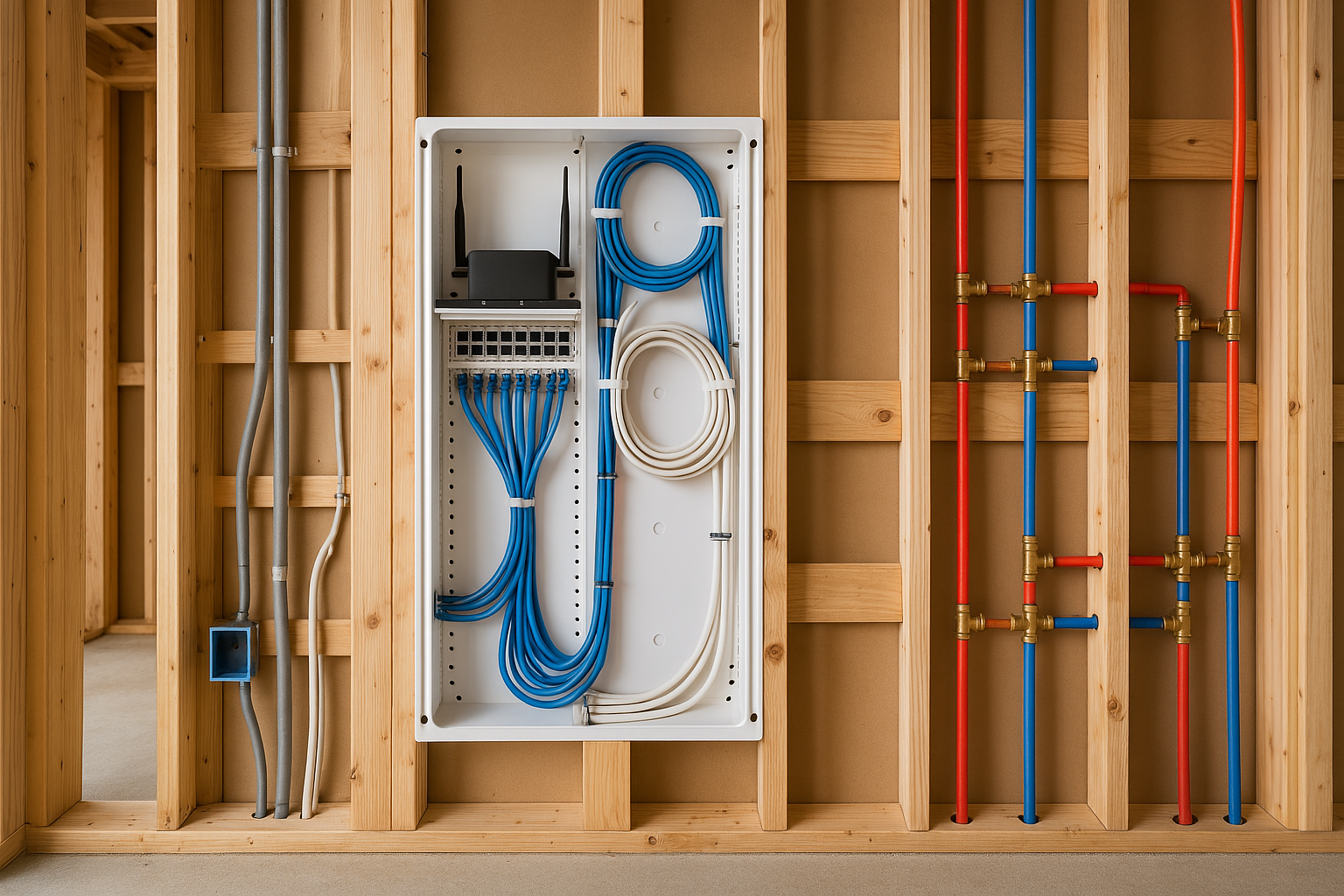
[Image: Comprehensive Smart Home Infrastructure Systems]
| Technology Infrastructure | Initial Investment | Annual Savings/Benefits |
|---|---|---|
| Whole-House Structured Wiring | $3,000-7,000 | Reliability and future-proofing value |
| Smart Electrical Panel | $2,500-4,000 | 8-15% energy savings |
| Automated Water Leak Detection | $800-2,000 | Potential savings of $10,000+ in water damage prevention |
| Smart Water Management System | $1,500-3,000 | 10-30% water usage reduction |
HVAC: Intelligent Climate Control
Modern HVAC systems represent one of the most significant opportunities for smart home integration, offering substantial energy savings, improved comfort, and enhanced air quality through intelligent controls and zoning.
Smart HVAC System Design Elements:
- Advanced Zoning Systems: Design multi-zone HVAC with independent temperature sensors and smart damper controls for room-by-room climate management.
- Smart Ventilation: Incorporate demand-controlled ventilation with CO2, humidity, and VOC sensors that automatically adjust fresh air intake based on occupancy and air quality parameters.
- Energy Recovery Ventilation: Install ERV/HRV systems with smart controls that optimize heat exchange efficiency based on indoor and outdoor conditions.
- Integrated Ductwork Sensors: Place temperature, humidity, and airflow sensors throughout the ductwork system to monitor system performance and identify maintenance needs preemptively.
Air Quality Management Integration:
- Comprehensive Monitoring: Install multi-parameter air quality sensing for particulates, VOCs, CO2, humidity, and temperature throughout the home.
- Automated Filtration Systems: Integrate high-MERV or HEPA filtration with smart monitoring that tracks filter life and performance.
- UV-C and Photocatalytic Purification: Consider in-duct air purification technologies that integrate with air quality monitoring systems.
- Smart Humidification/Dehumidification: Install whole-house humidity management systems with multi-point sensing and automated control.
Exterior Finishes: Tech-Forward Approach
Exterior finishes offer numerous opportunities to incorporate smart technology that enhances security, energy efficiency, and curb appeal while protecting your home from environmental factors.
Smart Exterior Technology Integration:
- Intelligent Access Control: Install smart door locks, video doorbells, and biometric entry systems with proper wiring and weather protection during door and window installation.
- Comprehensive Security System: Integrate motion-activated lighting, cameras with advanced analytics, environmental sensors, and perimeter monitoring during exterior finish installation.
- Smart Window Technology: Consider electrochromic glass or automated window coverings that respond to sunlight, temperature, and time of day to optimize energy efficiency.
- Weather-Resistant Technology Enclosures: Build weatherproof housing for outdoor speakers, Wi-Fi access points, and security equipment that blends with architectural elements.
Energy-Efficient Smart Exterior Options:
- Dynamic Exterior Shading: Install motorized exterior shades, awnings, or pergolas that automatically adjust based on sun position and weather conditions.
- Integrated Renewable Energy: Beyond roof-mounted options, consider building-integrated photovoltaics in railings, siding, or other exterior elements.
- Smart Exterior Lighting: Implement energy-efficient LED lighting with scheduling, motion detection, and scene control that integrates with home automation systems.
- Weather Monitoring Integration: Deploy sensors for wind, rain, temperature, and air quality that trigger automated responses like closing windows or adjusting HVAC.
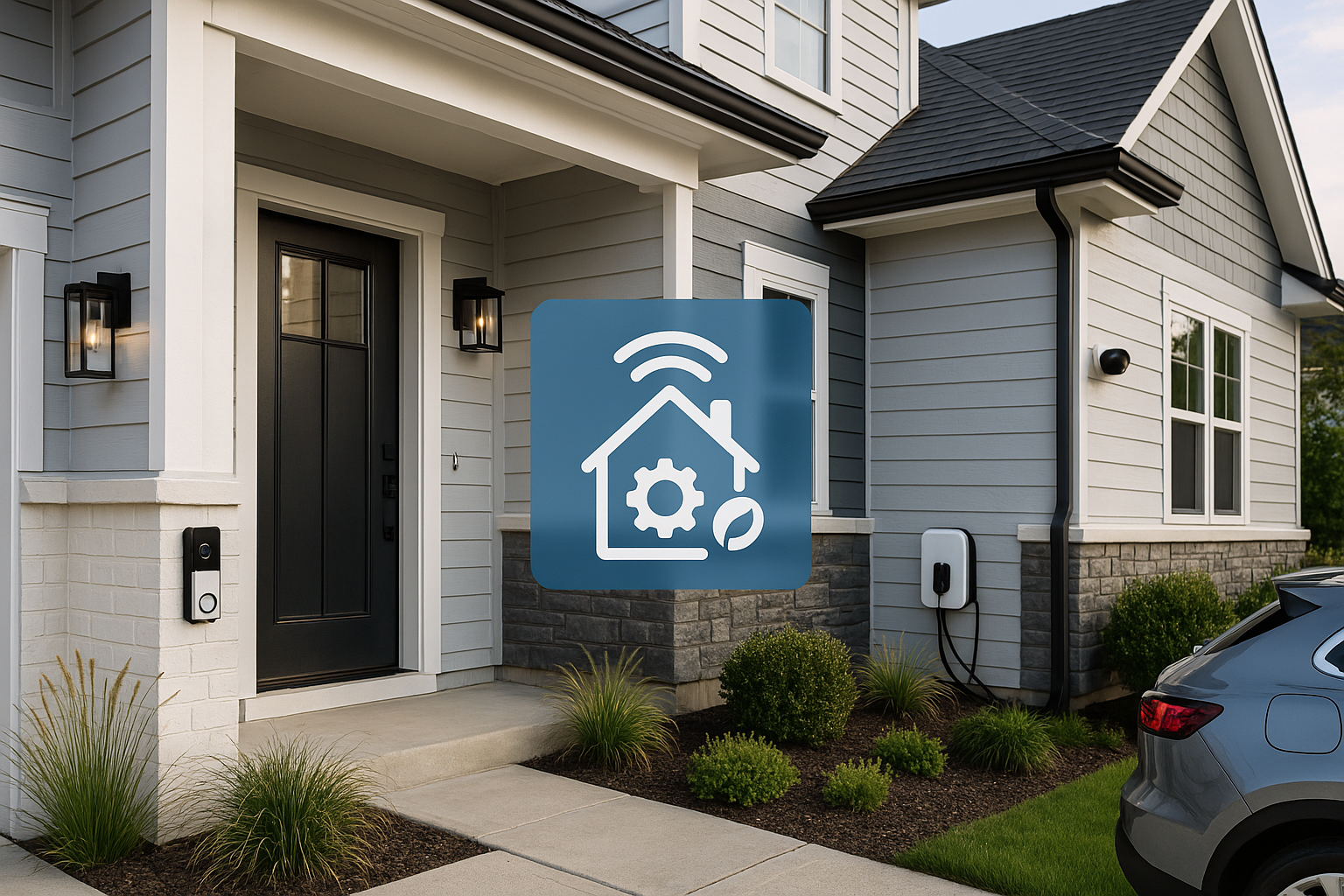
[Image: Smart Home Exterior Systems Integration]
Interior Finishes: Embedding Smart Technology
Interior finishes represent the final opportunity to seamlessly integrate visible smart home elements while concealing the technological infrastructure that powers your connected home.
Smart Interior Technology Integration:
- In-Wall Touch Panels: Install recessed touch screens for home control at key locations with proper backing and power/data connections.
- Invisible Speakers: Consider plaster-over or completely concealed audio systems installed during drywall phase for whole-home audio without visible components.
- Automated Lighting Design: Implement layered lighting with recessed fixtures, accent lighting, and task lighting all connected to smart controls with scene programming.
- Hidden Technology Integration: Create concealed projector lifts, TV mounts, and motorized cabinetry that reveal technology only when needed.
Smart Home User Interface Considerations:
- Voice Control Infrastructure: Plan for optimal microphone placement and acoustic considerations for voice assistant technology throughout the home.
- Gesture Control Integration: Consider embedded motion and gesture sensors in key areas for touchless control of lighting, appliances, and entertainment.
- Occupancy and Activity Monitoring: Install discreet presence sensors that drive automation based on which rooms are occupied and what activities are occurring.
- Wellness Technology: Incorporate circadian lighting systems, air quality monitoring, and smart sleep systems that support occupant health.
| Smart Interior Feature | Integration Complexity | Value Add | |
|---|---|---|---|
| Whole-Home Audio System | Medium | High (lifestyle enhancement) | |
| Automated Lighting Control | Medium-High | High (convenience, security, energy savings) | |
| Motorized Window Treatments | Medium | Medium-High (privacy, energy efficiency) | |
| In-Wall Touchscreen Controls | High | High (centralized control, aesthetic integration) |
| Technology System | Initial Investment | Annual Savings | Typical ROI Timeframe |
|---|---|---|---|
| Smart HVAC with Zoning | $4,000-8,000 | $400-800 | 5-8 years |
| Whole-House Water Management | $2,000-4,000 | $300-600 + risk mitigation | 3-6 years |
| Structured Network & WiFi | $3,000-6,000 | Reliability & future value | Property value enhancement |
| Smart Lighting Control | $3,000-10,000 | $200-500 | 6-10 years |
| Solar + Smart Energy Management | $15,000-30,000 | $1,500-3,000 | 5-10 years |
Future-Proofing Your Smart Home
Technology evolves rapidly, but thoughtful planning can ensure your smart home remains relevant, functional, and upgradeable for decades to come, protecting your investment and maintaining its value.
Long-Term Technology Planning Strategies:
- Modular System Design: Implement technology systems with modular components that can be individually upgraded without requiring wholesale replacement.
- Standardized Connectivity: Prioritize open standards and widely adopted protocols over proprietary systems whenever possible to maximize future compatibility.
- Physical Access Planning: Design your home with service corridors, accessible junction boxes, and removable panels that facilitate future technology updates with minimal disruption.
- Expandable Infrastructure: Install higher capacity electrical service, additional conduit capacity, and data backbone capabilities beyond current needs to accommodate future expansion.
Emerging Technology Accommodation:
- AI Integration Readiness: Design systems with local processing capabilities and sufficient sensor infrastructure to support future artificial intelligence applications.
- Robotics Preparation: Consider wider doorways, level thresholds, and navigation pathways that will accommodate future home robotics for cleaning, assistance, and security.
- Virtual/Augmented Reality: Create spaces with appropriate dimensions, lighting, and connectivity for future VR/AR applications in entertainment, education, and remote work.
- Health Technology Integration: Plan for future integration of health monitoring, telemedicine, and wellness technologies throughout the home environment.
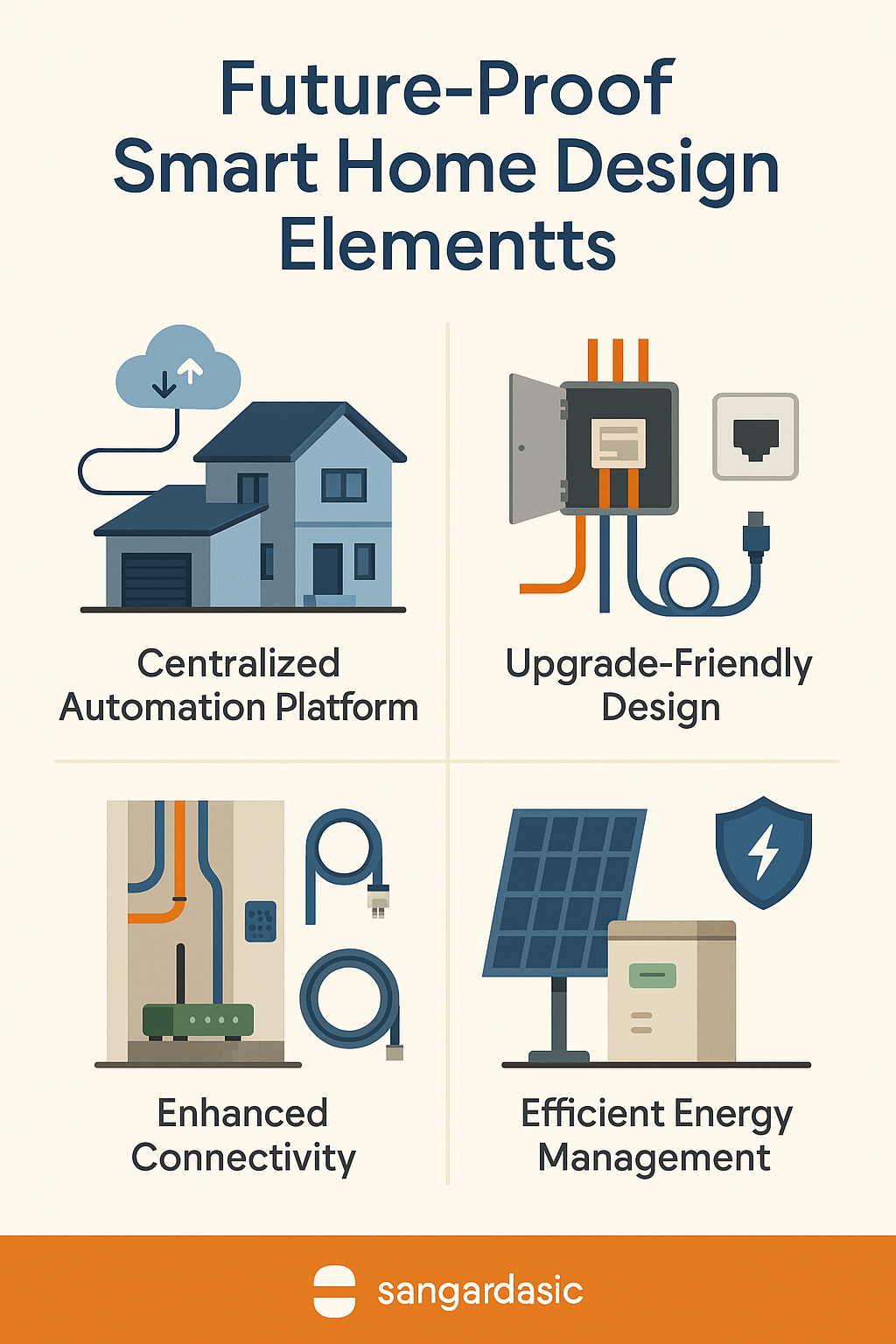
[Image: Future-Proof Technology Integration]
Conclusion: Building Your Smart Home Legacy
Constructing a smart home from the ground up represents a significant opportunity to create a living environment that enhances comfort, efficiency, security, and wellness for years to come. By thoughtfully planning and integrating technology at each stage of the construction process, you can build a home that not only meets your current needs but adapts to future innovations and lifestyle changes.
The initial investment in comprehensive smart home infrastructure during construction delivers substantial long-term returns through energy savings, maintenance prevention, enhanced property value, and improved quality of life. More importantly, it creates a technological foundation that can evolve alongside advances in smart home technology, ensuring your investment remains relevant and valuable for decades.
Whether you’re building a modest smart home or an advanced automated residence, the principles of thoughtful planning, quality infrastructure, and future-proof design apply at every scale. By partnering with knowledgeable architects, builders, and technology integrators who understand these principles, you can create a smart home that serves as a lasting legacy of innovation and intelligent design.
Apple’s BIGGEST Smart Home Move Ever (This May Change Everything)
Is Apple preparing its biggest push ever into the smart home industry?.. With plans for AI-powered displays, advanced cameras, and potentially revolutionary new features, this could change everything for HomeKit users and the smart home market as a whole. Let’s explore what this means for the future of Apple Home.
Your Tools
Access your tools to manage tasks, update your profile, and track your progress.
Collaboration Feed
Engage with others, share ideas, and find inspiration in the Collaboration Feed.

